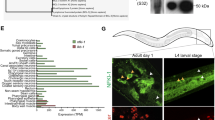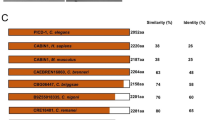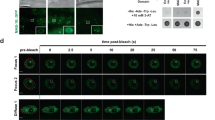Abstract
The signalling protein Wnt regulates transcription factors containing high-mobility-group (HMG) domains to direct decisions on cell fate during animal development1. In Caenorhabditis elegans, the HMG-domain-containing repressor POP-1 distinguishes the fates of anterior daughter cells from their posterior sisters throughout development2,3, and Wnt signalling downregulates POP-1 activity in one posterior daughter cell called E (refs 2, 4, 5). Here we show that the genes mom-4 and lit-1 are also required to downregulate POP-1, not only in E but also in other posterior daughter cells. Consistent with action in a common pathway, mom-4 and lit-1 exhibit similar mutant phenotypes and encode components of the mitogen-activated protein kinase (MAPK) pathway that are homologous to vertebrate transforming-growth-factor-β-activated kinase (TAK1) and NEMO-like kinase (NLK), respectively. Furthermore, MOM-4 and TAK1 bind related proteins that promote their kinase activities. We conclude that a MAPK-related pathway cooperates with Wnt signal transduction to downregulate POP-1 activity. These functions are likely to be conserved in vertebrates, as TAK1 and NLK can downregulate HMG-domain-containing proteins related to POP-1 (ref. 6).
This is a preview of subscription content, access via your institution
Access options
Subscribe to this journal
Receive 51 print issues and online access
$199.00 per year
only $3.90 per issue
Buy this article
- Purchase on Springer Link
- Instant access to full article PDF
Prices may be subject to local taxes which are calculated during checkout




Similar content being viewed by others
References
Cadigan, K. M. & Nusse, R. Wnt signaling: a common theme in animal development. Genes Dev. 11, 3286–3305 (1997).
Lin, R., Thompson, S. & Priess, J. R. pop-1 encodes an HMG box protein required for the specification of a mesoderm precursor in early C. elegans embryos. Cell 83, 599–609 (1995).
Lin, R., Hill, R. & Priess, J. R. POP-1 and anterior-posterior fate decision in C. elegans embryos. Cell 92, 229–240 (1998).
Rocheleau, C. E. et al. Wnt signaling and an APC-related gene specify endoderm in early C. elegans embryos. Cell 90, 707–716 (1997).
Thorpe, C. J., Schlesinger, A., Carter, J. C. & Bowerman, B. Wnt signaling polarizes an early C. elegans blastomere to distinguish endoderm from mesoderm. Cell 90, 695–705 (1997).
Ishitani, T. et al. The TAK1–NLK–MAPK-related pathway antagonizes signalling between β-catenin and transcription factor-TCF. Nature 399, 798–802 (1999).
Goldstein, B. Induction of gut in Caenorhabditis elegans embryos. Nature 357, 255–257 (1992).
Goldstein, B. An analysis of the response to gut induction in the C. elegans embryo. Development 121, 1221–1236 (1995).
Brunner, E., Peter, O., Schweizer, L. & Basler, K. pangolin encodes a Lef-1 homolog that acts downstream of Armadillo to transduce the Wingless signal. Nature 385, 829–833 (1997).
Riese, J. et al. LEF-1, a nuclear factor coordinating signaling inputs from wingless and decanpentaplegic. Cell 88, 777–787 (1997).
van de Wetering, M. et al. Armadillo co-activates transcription driven by the product of the Drosophila segment polarity gene dTCF. Cell 88, 788–799 (1997).
Bienz, M. TCF: transcriptional activator or repressor? Curr. Opin. Cell Biol. 10, 366–372 (1998).
Brannon, M., Gomperts, M., Sumoy, L., Moon, R. T. & Kimelman, D. Aβ-catenin/XTcf-3 complex binds to the siamois promoter to regulate dorsal axis specification in Xenopus. Genes Dev. 11, 2359–2370 (1997).
Cavallo, R. A. et al. Drosophila Tcf and Groucho interact to repress Wingless signalling activity. Nature 395, 604–608 (1998).
Roose, J. et al. The Xenopus Wnt effector XTcf-3 interacts with Groucho-related transcriptional repressors. Nature 395, 608–612 (1998).
Kaletta, T., Schnabel, H. & Schnabel, R. Binary specification of the embryonic lineage in Caenorhabditis elegans. Nature 390, 294–298 (1997).
Yamaguchi, K. et al. Identification of a member of the MAPKKK family as a potential mediator of TGF-β signal transduction. Science 270, 2008–2011 (1995).
Shibuya, H. et al. TAB1: an activator of the TAK1 MAPKKK in TGF-β signal transduction. Science 272, 1179–1182 (1996).
Fire, A., Montgomery, M. K., Kostas, S. A., Driver, S. E. & Mello, C. C. Potent and specific genetic interference by double-stranded RNA in Caenorhabditis elegans. Nature 391, 806–811 (1998).
Mello, C. C., Kramer, J. M., Stinchcomb, D. & Ambros, V. Efficient gene transfer in C. elegans : extrachromosomal maintenance and integration of transforming sequences. EMBO J. 10, 3959–3970 (1991).
Brott, B. K., Pinsky, B. A. & Erikson, R. L. Nlk is a murine protein kinase related to Erk/MAP kinases and localized in the nucleus. Proc. Natl Acad. Sci. USA 95, 963–968 (1998).
Choi, K. W. & Benzer, S. Rotation of photoreceptor clusters in the developing Drosophila eye requires the nemo gene. Cell 78, 125–136 (1994).
Brenner, S. The genetics of Caenorhabditis elegans. Genetics 77, 71–94 (1974).
Epstein, H. F. & Shakes, D. C. Caenorhabditis elegans: Modern Biological Analysis of an Organism(Academic, San Diego, 1995).
Avery, L., Horvitz, H. R. Pharyngeal pumping continues after laser killing of the pharyngeal nervous system of C. elegans. Neuron 3, 473–485 (1989).
Bowerman, B., Eaton, B. A. & Priess, J. R. skn-1, a maternally expressed gene required to specify the fate of ventral blastomers in the early C. elegans embryo. Cell 68, 1061–1075 (1992).
Priess, J. R. & Thomson, J. N. Cellular interactions in early C. elegans embryos. Cell 34, 85–100 (1987).
Fields, S. & Sternglanz, R. The two-hybrid system: an assay for protein–protein interactions. Trends Genet. 8, 286–292 (1994).
Acknowledgements
We thank J. Willis for assistance with POP-1 antibody staining; D. Miller, R. Lin and J. Ahringer for providing antibodies; the C. elegans Genetics center, funded by the NIH National Center for Research Resources, for providing strains; H. and R. Schnabel for the t1534 lit-1 allele; and B. Draper and C. Doe for helpful comments on the manuscript. B.B. is supported by an NIH R01 grant and M.M. by an NIH Genetics training grant.
Author information
Authors and Affiliations
Corresponding author
Rights and permissions
About this article
Cite this article
Meneghini, M., Ishitani, T., Carter, J. et al. MAP kinase and Wnt pathways converge to downregulate an HMG-domain repressor in Caenorhabditis elegans. Nature 399, 793–797 (1999). https://doi.org/10.1038/21666
Received:
Accepted:
Issue Date:
DOI: https://doi.org/10.1038/21666
This article is cited by
-
Depletion of MOB1A/B causes intestinal epithelial degeneration by suppressing Wnt activity and activating BMP/TGF-β signaling
Cell Death & Disease (2018)
-
Nemo-like kinase regulates the expression of vascular endothelial growth factor (VEGF) in alveolar epithelial cells
Scientific Reports (2016)
-
Expression of Nemo-like kinase after spinal cord injury in rats
Journal of Molecular Neuroscience (2014)
Comments
By submitting a comment you agree to abide by our Terms and Community Guidelines. If you find something abusive or that does not comply with our terms or guidelines please flag it as inappropriate.



